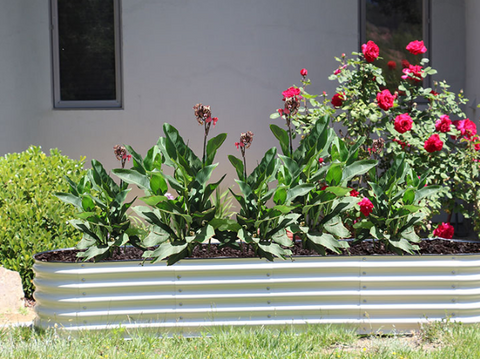Tips from Olle Garden Bed: 4 Ways To Keep Cats Out Of Flower Beds & The Vegetable Garden
We gardeners like beautiful, wonderful and unusual things. For most of us, this includes cats. As gardeners, it is sometimes challenging to balance our love for plants, wild animals we encourage and our interesting feline friends. The following content also has some reference value for raised garden beds.
Strange, lively and unpredictable.
There are all kinds of cats, ranging from cute and spoiled companions to rogue neighbors and bullies.
In the urban environment, the beloved cat is regarded as the best domestic pet that can be safely kept indoors.
In the countryside, cats are important hunters and can control small rodent populations.
In urban and rural areas, domestic cats do pose challenges to wildlife, especially songbirds.

Hard work or destructive and destructive?
Cats dominate their habitats and nap wherever they like. They crush their favorite plants, or dig and trample anywhere they want.
They left a mess behind. This is harmful to the health of plants and soil, and it is no fun for gardeners.
In the professional column, cats really help prevent and reduce the population of small rodents. It is noteworthy that mice, voles, moles and rats. These are also harmful to gardens and vegetable crops, and may carry diseases that are not popular with humans.
However, domestic cats do pose a major threat to wildlife, especially songbirds.
Strike a balance
Of course, we want to be as friendly to cats as possible. In particular, when it is your own furry friend, you want to stay away from the garden bed!
Those neighborhood villains, male cats, stray cats and wild cats also need our kindness!
Therefore, the challenge is to protect the safety of our beloved furry cats, make other cats unpopular, and protect wild animals.
Here are some strategies to achieve these goals, for our beautiful, rich and blooming backyard!
4 friendly ways to keep cats away from flowers and vegetable beds
- Make the cat uncomfortable.
The cat seemed to lie on almost anything. You can walk almost anywhere. Well, maybe not.
A sharp stone covering. A leaf with thorns. Spiny pine cones. Barbed, bristly branches. Try to create surfaces throughout the garden that the cat does not want to tread or spread.
Sound emission deterrence and motion sensor sprinklers will enable the cat to wave a white flag when retreating.
Cats can't stand certain smells. Lemon peel, cinnamon or old coffee grounds can be sprinkled around to protect them from cats.
Pepper and black pepper are also unfriendly smells for cats, but they should be gentle, because too much may harm sensitive nose, mouth and respiratory tract.
- Planting plants that cats hate
Strong smelling plants can be loved or hated by cats.
It is worth noting that Ruxiang, lavender, mugwort, rosemary, geranium and marigold are obviously disliked by cats.
I have achieved great success in driving my cat out of the flower bed by planting lemon gem marigold, Tagetesenuifolia, which borders on other knickerbockers. They have a delicious light lemon flavor, not loved by cats!
Yes, cats are weird. Your cat may love or hate some plants more than others!
Avoid using plant cats, generally speaking, love. Of course, the plants that many cats like are cat mint or cat mint (Nepetasp.), Jacob's ladder, valerian and flax.
- Create a cat protection area
well! Look this way! The perfect cat jammer!
Make an area suitable for cats and away from precious flowers.
Use plants that cats like, such as cat mint and valerian.
Create a smooth, comfortable surface that the cat may like.
You can warm up in a sunny place and lazily spend the afternoon in a cool place. Oh, be a cat!
- Build outdoor cat fence
In urban areas, many veterinarians recommend leaving cats indoors to ensure their safety and comfort.
In fine weather, those cats may go out restlessly. For them, you can consider building an outdoor cat enclosure.
Outdoor cat enclosure can protect your blooming flower bed. In addition, it can also protect your cat's health. Wild animals, including songbirds, are also kept out of reach.
Protect wild animals
Bird feeder, bird bath and hummingbird nectar feeder all add beauty and drama to the landscape and our flower beds.
Placement is key because these garden objects will also attract predators, our furry feline friends.
Domestic cats and other pets have some advantages over wild animals.
Wild animals spend 100% of their time outdoors looking for food and safe habitats.
Migratory birds travel incomprehensible miles during each migration. Tired travelers and migratory birds face high risks from predators.
It is our goal as pet owners to let pet cats generally eat enough, have a good rest, care and keep the best health.

For this reason, pets are powerful hunters of wild animals.
As mentioned earlier, our cats benefit from our efforts to prevent rodent pests.
At the same time, it is necessary to protect small birds, songbirds and migratory birds from our powerful cat hunters.
Wildlife gardening is a magnificent and glorious work. To do this, make sure that the bird feeder, bird bath and hummingbird nectar feeder are kept out of the cat's reach.
Being creative and cunning, it may be a challenge to outwit some predatory cats.
Try hanging the feeder from the pole and placing the bird bath or feeder on an inaccessible stand.
Bird friendly landscaping should include cat deterrence, such as the use of strong smells, sharp coverings, and areas considered uncomfortable for cats.
Finding a friendly way to keep cats away from flower beds will not only help protect our beautiful backyard, but also help protect wild animals!
